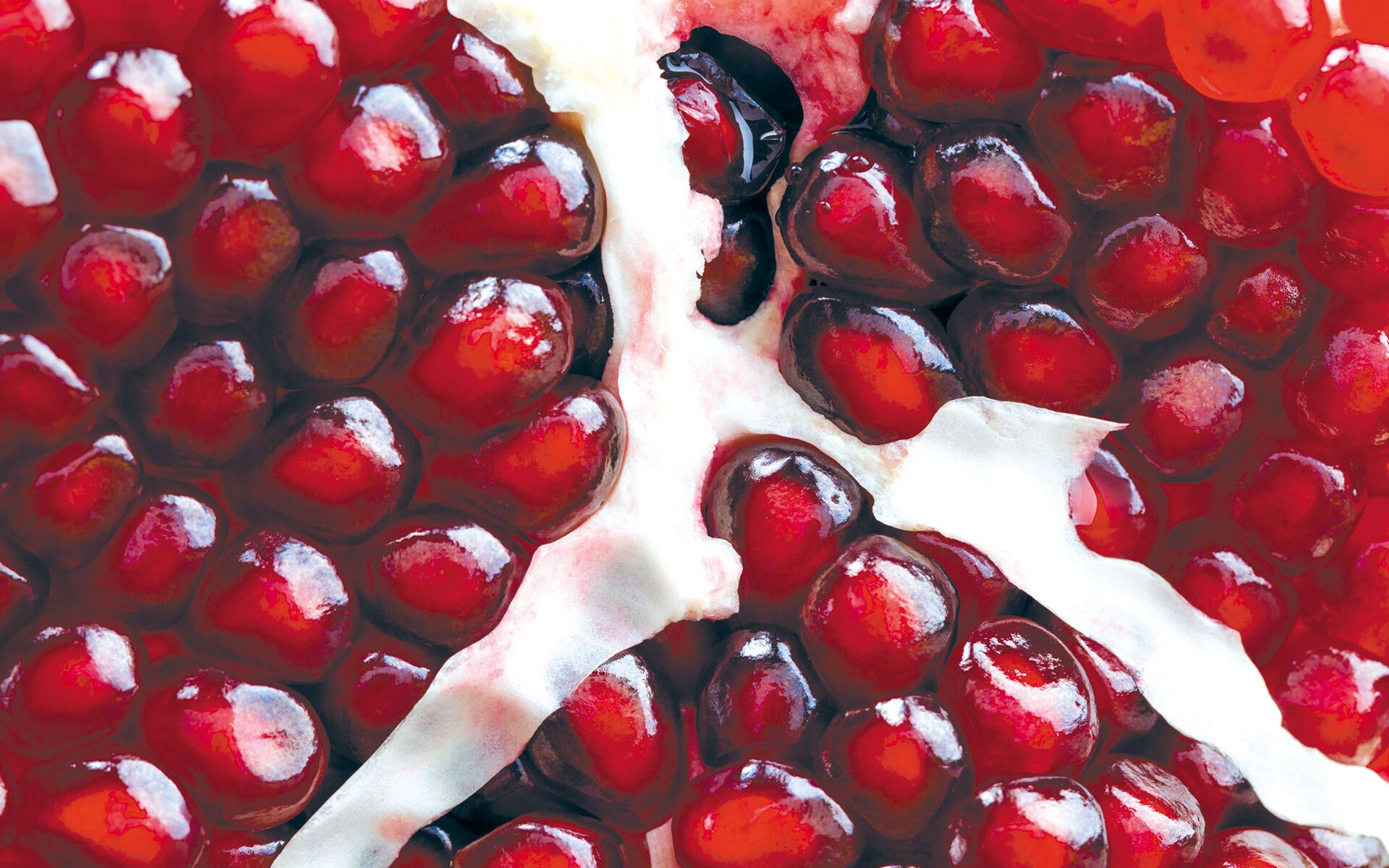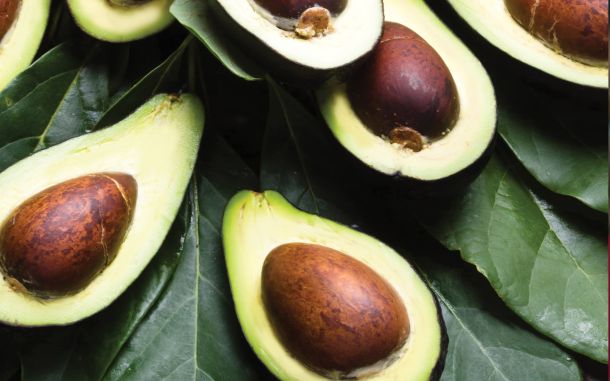Pomegranate

In This Article
-
The pomegranate is widely consumed due to its nutritional properties, benefits, and taste. Unlike many fruit trees, both male and female pomegranate flowers are produced on the same tree.
-
Pomegranate seeds get their red hue from polyphenols. These antioxidants can help destroy free radicals, protect cells from damage, and reduce inflammation.
The pomegranate (Punica granatum L.) is a fruit with abundant seeds and a perfect packaging. A vital food and medicine provider across different civilizations for thousands of years, the pomegranate has a different taste depending on variety and maturity. It may taste very sweet, very sour, or sharp. Botanically, it is a fleshy fruit from the berry group with an ovary from a single flower and typically has several seeds. The crown jewel of the fruit world, the pomegranate is widely consumed due to its nutritional properties, benefits, and taste. Unlike many fruit trees, both male and female pomegranate flowers are produced on the same tree, meaning the male flower can pollinate other flowers on the same tree or other trees.
Astonishing due to its extraordinary packaging system, the pomegranate has been grown in the tropical regions of India, Asia, the Mediterranean, and Africa for centuries. Since ancient times, is has been a symbol of fertility and has been depicted in different arts throughout history. The fruit has different meanings in various beliefs and religions and is introduced in three verses in the Qur'an, where it is called rumman. “There are (unseen) fruits, dates and pomegranates in (these two paradises)” [1]. Mentioned in the verse as a fruit of paradise, it can be consumed fresh and used in the manufacture of medicine and dyes. It can also be processed into pomegranate molasses, syrup, seed oil, fruit juice, or vinegar. In the Indian alternative medicine system (Ayurveda), the pomegranate is considered “a pharmacy in itself.” And while it is widely used as a hemostatic and antimicrobial agent in Persian traditional medicine, its husk has been used to cure asthma, chronic diarrhea, dysentery, and intestinal worms. Its juice has been used in the treatment of aphthae and ulcers in India, Tunisia, and Guatemala [2]. Bediuzzaman gives pomegranate as an example to portray God’s blessings upon us: “While the pomegranate tree contents itself with muddy and turbid water, it feeds its fruit with a pure drink from the treasure of Divine Mercy” (The Seventeenth Gleam, Eighth Note). “For by exhibiting a wise beauty of art, as well as meaningful and subtle ornament, that amaze all minds, it has displayed a work of art like an ode in praise of the All-Majestic Maker. Look carefully at pomegranates and ears of corn, for example” (Thirtieth Word). There is an exclusive art and wisdom in each fruit bestowed from our Lord's treasury of mercy.
The pomegranate husk
The red-violet husk has two parts: the outer part (hard, pericarp) and the inner part (white, spongy, mesocarp). The mesocarp is where the inner wall grains (aryls) are attached. Inner membranes are arranged in unsymmetrical chambers for the aryls. The husk makes up approximately 30-40% of the fruit. It contains phenolic compounds, flavonoids, tannins, and phenolic acids as well as punicalagin (a toxin-repellent substance), with its distinctly high antioxidant effect. Thanks to this feature, the pomegranate husk is widely used in the pharmaceutical industry for its anti-carcinogenic and antibacterial effects. Research showed strong antibacterial activity in the active ingredients of the pomegranate husk, especially against E. coli, E. faecalis, S. aureus, and B. subtilis [3]. It has also been shown that it may have a potential effect in the prevention and treatment of obesity as well as against fungi such as Aspergillus flavus [4]. The pomegranate husk, which we usually discard, is known for its helpful effects against diabetes, cancer, and cardiovascular diseases [5]. It also has higher antioxidant potential than the pulp, seed, and juice extracts. This is one of the best proofs nothing is useless or worthless. Some studies have shown that husk extract may be beneficial against diseases such as Alzheimer's and dementia thanks to its memory-enhancing effect. As per findings, it also reduces blood sugar (glucose), cholesterol and its derivatives, and increases hemoglobin levels [6]. The pomegranate husk can be made into tea or consumed as spice additive.
Pomegranate seeds
Drawing attention with their resemblance to blood cells, pomegranate seeds get their red hue from polyphenols. These antioxidants can help destroy free radicals, protect cells from damage, and reduce inflammation. They sustain the skin health, and support the heart and veins to be healthy and flexible, and keep blood values at normal levels. Pomegranates contain three times more antioxidants than green tea and other fruit juices due to the punicalagin found in their seeds [7]. Pomegranate seeds are also rich in vitamins and minerals such as vitamin C, iron, potassium, phosphorus, sodium, and zinc.
In some cultures, the pomegranate represents fertility. This may be in relation to the fact that they contain hormones that support reproduction—another reason could be that there are as many as 600-1000 pomegranate seeds in one pomegranate. Oxidative stress has been revealed to cause egg dysfunction and reduction of fertility in women. Pomegranates help reduce oxidative stress and may increase fertility. Pomegranate seeds can increase testosterone levels in men and estrogen hormone levels in women [8].
Specially packaged in their membrane called pericarp, the pomegranate seeds (aryls) are presented to us as a delicious healing store [9]. Besides easing stomach ailments, the pomegranate seeds also help regulate blood circulation and alleviate heart-related problems, dental problems, osteoarthritis, anemia, and diabetes.
Pomegranate juice
While the consumption of fruit juice is not advised in functional medicine due to fructose and pulp-free content, pomegranate juice is allowed. Pomegranate juice contains anthocyanin, glucose, ascorbic acid, ellagic acid, gallic acid, catechin, amino acids, iron, and minerals. Since ancient times, pomegranate has often been recommended for digestive system disorders. Recent studies reveal the improvement of cardiac functions in patients who drink pomegranate juice every day for three months [10]. Pomegranate juice has also been discovered to reduce colon cancer cells and prevent the development of prostate tumors in men and breast tumors in women [11]. Pomegranate juice is the best juice for heart health. As studies have shown, pomegranate juice improves blood flow, prevents hardening and thickening of the arteries, and can slow the growth of plaque and the accumulation of cholesterol. However, pomegranate may react negatively with blood pressure and cholesterol medications like statins [12]. Those who are on medication should consume pomegranate juice with caution. Pomegranate juice can heal inflammation in the intestines and can help solve digestive problems [13]. Since it contains 28-30% tannins, the pomegranate husk is also used in fabric dyeing and ink production, especially in leather.
The beauty and elegance of the pomegranate flower also heralds the taste and benefits of the fruit still in formation. The pomegranate, with its myriad forms, is a source of healing from cancer to diabetes, from blood pressure to heart diseases, from cosmetics to antibacterial and antimicrobial diseases. It is a fruit that should be consumed in abundance, especially in fall and winter. Pomegranate Gives many reasons for us to ponder over the many blessings we are bestowed with in this world.
References
- Holy Qur’an, 55:68.
- Khwairakpam, A. D., Bordoloi, D., Thakur, K. K., Monisha, J., Arfuso, F., Sethi, G., ... & Kunnumakkara, A. B. (2018). Possible use of Punica granatum (Pomegranate) in cancer therapy. Pharmacological research, 133, 53-64.
- Moneim, A. E. A. (2012). Antioxidant activities of Punica granatum (pomegranate) peel extract on brain of rats. Journal of Medicinal Plants Research, 6(2), 195-199.
- Wu, D., Ma, X., & Tian, W. (2013). Pomegranate husk extract, punicalagin and ellagic acid inhibit fatty acid synthase and adipogenesis of 3T3-L1 adipocyte. Journal of Functional Foods, 5(2), 633-641.
- Moneim, A. E. A. (2012). Antioxidant activities of Punica granatum (pomegranate) peel extract on brain of rats. Journal of Medicinal Plants Research, 6(2), 195-199.
- Radhika, S., Smila, K. H., & Muthezhilan, R. (2011). Antidiabetic and hypolipidemic activity of Punica granatum Linn on alloxan induced rats. World Journal of Medical Sciences, 6(4), 178-182.
- Gil, M. I., Tomás-Barberán, F. A., Hess-Pierce, B., Holcroft, D. M., & Kader, A. A. (2000). Antioxidant activity of pomegranate juice and its relationship with phenolic composition and processing. Journal of Agricultural and Food chemistry, 48(10), 4581-4589.
- Al-Dujaili, E., & Smail, N. (2012, March). Pomegranate juice intake enhances salivary testosterone levels and improves mood and well-being in healthy men and women. In Endocrine Abstracts(Vol. 28). Bioscientifica.
- About the membranes, Ali ibn Abu Talib said, “Eat the pomegranate with its membrane, for it cleanses the stomach” (Ahmed ibn Hanbal, V, 382).
- Sahebkar, A., Ferri, C., Giorgini, P., Bo, S., Nachtigal, P., & Grassi, D. (2017). Effects of pomegranate juice on blood pressure: A systematic review and meta-analysis of randomized controlled trials. Pharmacological Research, 115, 149-161.
- https://www.healthline.com/nutrition/12-proven-benefits-of-pomegranate#TOC_TITLE_HDR_6
- https://www.nccih.nih.gov/health/pomegranate
- https://www.medicalnewstoday.com/articles/318385









